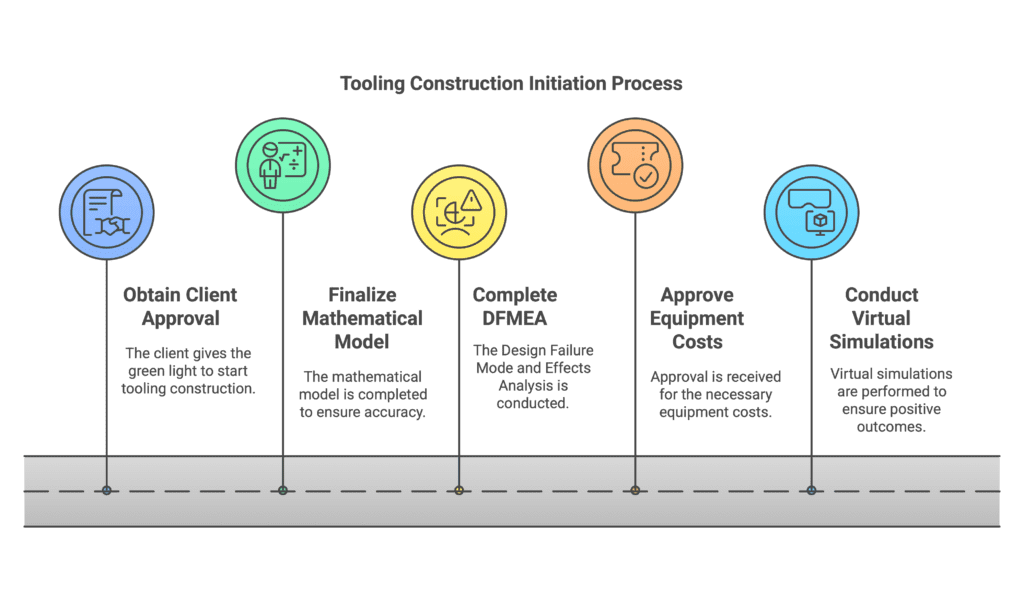Regardless of whether the organization or the client is responsible for the project, proper management of equipment status is crucial for a successful launch. The Off Tool Off Process, which signifies the finalization of the process in its designated location, is of utmost importance.
Types of Equipment Status
When defining the launch schedule, the client will request the preparation of an appropriate timetable. This schedule will encompass various pieces of information, including:
- Customer milestones,
- Customer activities related to parts approval in the production process,
- The status of equipment and components at each pre-launch phase, which are of particular interest.
The Off Tool Off Process signifies the final status, but what marks the beginning?
The organization’s starting point for initiating tooling construction is obtaining approval from the client, referred to as Tooling Kick Off (TKO). This involves:
- Finalizing the mathematical model
- Completing the Design Failure Mode and Effects Analysis (DFMEA)
- Receiving approval for the equipment costs required for product production
- Conducting relevant virtual simulations, typically utilizing the Finite Element Method (FEM) to ensure positive outcomes. This detail holds particular relevance to me due to its alignment with my field of study. 😊
It’s crucial to note that the equipment will undergo all necessary control tests.

For complex products or the integration of new technologies, we may also offer customer support during the launch phase. For example:
- Laser cutting of the dashboard instrument panel in the passenger explosion zone, known as the bridging effect
- Development of injection molds for dashboards or bumpers
Off Tool – The Initial Stage of Tooling Status
When approval for tooling construction is granted, the client will categorize it into two components. The first component is the “off tool” status, representing a definitive process in a non-definitive location.
What does this entail? Firstly, it’s important to note that this stage may not always occur during the pre-launch phase. Why? Because it applies to a specific category of products.
For instance, if we’re manufacturing components that are:
- Injected
- Stamped
- Thermoformed
The production of these components initially occurs at the toolmaker’s facility. This constitutes our off tool status.
This approach offers a distinct advantage: when we receive initial feedback from the client regarding geometric inconsistencies, the mold designer can promptly address them.

OT (Off Tool) assumes various forms. Apart from the one mentioned earlier, it can denote a process that isn’t definitive at the organization’s premises. Examples encompass manual:
- welding instead of automatic
- painting instead of automatic
- plastic flash removal instead of automatic
During the launch phase, customers typically split it into two segments. Initially, they request components with OT status from us. Subsequently, they seek Off Tool Off Process, which I will elaborate on below.
Off Tool Off Process – a critical tooling status for customer part approval
This equipment status holds immense importance for the organization. The sooner it’s achieved, the more time we’ll have to present the part to the customer for approval. Depending on the client, it may be referred to as PPAP, PPA, or Plant Evaluation.
In various scenarios, the situation is clear-cut. The Off Tool Off Process status arises when the molds are transferred to a specific plant. Another scenario involves replacing a manual process with an automatic one, as previously agreed upon with the client.
Additionally, the schedule may include the following statuses:
- Prototype tooling: Used to manufacture parts dedicated to conducting validation tests.
- Partially prototype: A hybrid status combining aspects of the prototype and off tool statuses.
From the organization’s plant perspective, these statuses are somewhat less significant as they relate to pre-series components.
Dariusz Kowalczyk


